Potential Modulation of Aerosol on Precipitation Efficiency in Southwest China
Abstract
:1. Introduction
2. Data and Methodology
3. Results and Discussion
3.1. Aerosol, Cloud Water, Precipitation, and PE
3.2. Relation between the Cloud Water Path and Precipitation
3.3. Potential Modulation of Aerosol on PE
4. Conclusions
Author Contributions
Funding
Data Availability Statement
Acknowledgments
Conflicts of Interest
References
- Ramanathan, V.; Cess, R.D.; Harrison, E.F.; Minnis, P.; Barkstrom, B.R.; Ahmad, E.; Hartmann, D. Cloud-Radiative Forcing and Climate: Results from the Earth Radiation Budget Experiment. Science 1989, 243, 57–63. [Google Scholar] [CrossRef]
- Rosenfeld, D.; Ulbrich, C.W. Cloud Microphysical Properties, Processes, and Rainfall Estimation Opportunities. Meteor. Monogr. 2003, 30, 237–258. [Google Scholar] [CrossRef]
- Soden, B.J.; Held, I.M. An assessment of climate feedbacks in coupled ocean-atmosphere models. J. Clim. 2006, 19, 3354–3360. [Google Scholar] [CrossRef]
- Rosenfeld, D.; Gutman, G. Retrieving microphysical properties near the tops of potential rain clouds by multispectral analysis of AVHRR data. Atmos. Res. 1994, 34, 259–283. [Google Scholar] [CrossRef]
- Rapp, A.D. Observational evidence linking precipitation and mesoscale cloud fraction in the southeast Pacific. Geophys. Res. Lett. 2016, 43, 7267–7273. [Google Scholar] [CrossRef]
- Murakami, Y.; Kummerow, C.D.; Van Den Heever, S.C. On the Relation among Satellite-Observed Liquid Water Path, Cloud Droplet Number Concentration and Cloud Base Rain Rate and Its Implication to the Auto-Conversion Parameterization in Stratocumulus Clouds. J. Clim. 2021, 34, 8165–8180. [Google Scholar] [CrossRef]
- Sun, J.; Shi, Z.; Chai, J.; Xu, G.; Niu, B. Effects of Mixed Phase Microphysical Process on Precipitation in a Simulated Convective Cloud. Atmosphere 2016, 7, 97. [Google Scholar] [CrossRef]
- Liu, Y.; Luo, R.; Zhu, Q.; Hua, S.; Wang, B. Cloud ability to produce precipitation over arid and semiarid regions of Central and East Asia. Int. J. Climatol. 2019, 40, 1824–1837. [Google Scholar] [CrossRef]
- Zhao, P.; Xiao, H.; Liu, J.; Zhou, Y. Precipitation efficiency of cloud and its influencing factors over the Tibetan plateau. Int. J. Climatol. 2022, 42, 416–434. [Google Scholar] [CrossRef]
- Tang, L.; Gao, W.; Xue, L.; Zhang, G.; Guo, J. Climatological Characteristics of Hydrometeors in Precipitating Clouds over Eastern China and Their Relationship with Precipitation Based on ERA5 Reanalysis. J. Appl. Meteor. Climatol. 2023, 62, 625–641. [Google Scholar] [CrossRef]
- Huang, Y.; Cui, X. Dominant Cloud Microphysical Processes of a Torrential Rainfall Event in Sichuan, China. Adv. Atmos. Sci. 2015, 32, 389–400. [Google Scholar] [CrossRef]
- Huang, Y.; Cui, X.; Wang, Y. Cloud microphysical differences with precipitation intensity in a torrential rainfall event in Sichuan, China. Atmos. Oceanic Sci. Lett. 2016, 9, 90–98. [Google Scholar] [CrossRef]
- Gao, W.; Liu, L.; Li, J.; Lu, C. The Microphysical Properties of Convective Precipitation Over the Tibetan Plateau by a Subkilometer Resolution Cloud-Resolving Simulation. J. Geophys. Res. Atmos. 2018, 123, 3212–3227. [Google Scholar] [CrossRef]
- Tang, J.; Guo, X.; Chang, Y. A Numerical Investigation on Microphysical Properties of Clouds and Precipitation over the Tibetan Plateau in Summer 2014. J. Meteorol. Res. 2019, 33, 463–477. [Google Scholar] [CrossRef]
- Wang, C.; Shi, H.; Hu, H.; Wang, Y.; Xi, B. Properties of cloud and precipitation over the Tibetan Plateau. Adv. Atmos. Sci. 2015, 32, 1504–1516. [Google Scholar] [CrossRef]
- Chen, B.; Zhang, W.; Yang, S.; Xu, X. Identifying and contrasting the sources of the water vapor reaching the subregions of the Tibetan Plateau during the wet season. Clim. Dyn. 2019, 53, 6891–6907. [Google Scholar] [CrossRef]
- Sui, C.H.; Satoh, M.; Suzuki, K. Precipitation efficiency and its role in cloud-radiative feedbacks to climate variability. J. Meteorol. Soc. Jpn. 2020, 98, 261–282. [Google Scholar] [CrossRef]
- Sui, C.H.; Li, X.; Yang, M.J. On the definition of precipitation efficiency. J. Atmos. Sci. 2007, 64, 4506–4513. [Google Scholar] [CrossRef]
- Liu, X.; Chen, Q.; Che, H.; Zhang, R.; Gui, K.; Zhang, H.; Zhao, T. Spatial distribution and temporal variation of aerosol optical depth in the Sichuan basin, China, the recent ten years. Atmos. Environ. 2016, 147, 434–445. [Google Scholar] [CrossRef]
- Liao, T.; Gui, K.; Li, Y.; Wang, X.; Sun, Y. Seasonal distribution and vertical structure of different types of aerosols in southwest China observed from CALIOP. Atmos. Environ. 2021, 246, 118145. [Google Scholar] [CrossRef]
- Zhang, K.; Zhao, C.; Fan, H.; Yang, Y.; Sun, Y. Toward understanding the differences of PM 2.5 characteristics among five China urban cities. Asia-Pac. J. Atmos. Sci. 2020, 56, 493–502. [Google Scholar] [CrossRef]
- Fan, H.; Zhao, C.; Yang, Y. A comprehensive analysis of the spatio-temporal variation of urban air pollution in China during 2014–2018. Atmos. Environ. 2020, 220, 117066. [Google Scholar] [CrossRef]
- Liu, J.; Zhao, C.; Lin, Y.; Zhang, Q.; Liu, H.; Xiao, Q.; Peng, Y. Potential impacts of aerosol on diurnal variation of precipitation in autumn over the Sichuan Basin, China. J. Geophys. Res. Atmos. 2022, 127, e2022JD036674. [Google Scholar] [CrossRef]
- Zhao, C.; Yang, Y.; Chi, Y.; Sun, Y.; Zhao, X.; Letu, H.; Xia, Y. Recent progress in cloud physics and associated radiative effects in China from 2016 to 2022. Atmos. Res. 2023, 293, 106899. [Google Scholar] [CrossRef]
- Huo, F.; Jiang, Z.; Ma, H.; Li, Z.; Li, Y. Reduction in autumn precipitation over Southwest China by anthropogenic aerosol emissions from eastern China. Atmos. Res. 2021, 257, 105627. [Google Scholar] [CrossRef]
- Fan, J.; Rosenfeld, D.; Yang, Y.; Zhao, C.; Leung, L.R.; Li, Z. Substantial contribution of anthropogenic air pollution to catastrophic floods in Southwest China. Geophys. Res. Lett. 2015, 42, 6066–6075. [Google Scholar] [CrossRef]
- Lu, H.; Xie, M.; Liu, B.; Liu, X.; Feng, J.; Yang, F.; Zhao, X.; You, T.; Wu, Z.; Gao, Y. Impact of atmospheric thermodynamic structures and aerosol radiation feedback on winter regional persistent heavy particulate pollution in the Sichuan-Chongqing region, China. Sci. Total Environ. 2022, 842, 156575. [Google Scholar] [CrossRef] [PubMed]
- Zhao, P.; Li, Z.; Xiao, H.; Wu, F.; Zheng, Y.; Cribb, M.C.; Jin, X.; Zhou, Y. Distinct aerosol effects on cloud-to-ground lightning in the plateau and basin regions of Sichuan, Southwest China. Atmos. Chem. Phys. 2020, 20, 13379–13397. [Google Scholar] [CrossRef]
- Zhu, S.; Xiao, Z.; Che, H.; Chen, Q. Impact of aerosols on warm clouds over the Sichuan Basin, China in winter based on the MERRA-2 reanalysis dataset. Atmos. Pollut. Res. 2022, 13, 101342. [Google Scholar] [CrossRef]
- Market, P.; Allen, S.; Scofield, R.; Kuligowski, R.; Gruber, A. Precipitation efficiency of warm-season Midwestern mesoscale convective systems. Weather Forecast. 2003, 18, 1273–1285. [Google Scholar] [CrossRef]
- TRMM (TMPA/3B43) Rainfall Estimate L3 1 Month 0.25 Degree × 0.25 Degree V7, Greenbelt, MD, Goddard Earth Sciences Data and Information Services Center (GES DISC). Available online: https://disc.gsfc.nasa.gov/datasets/TRMM_3B43_7/summary (accessed on 16 April 2024).
- Zhao, T.; Yatagai, A. Evaluation of TRMM 3B42 product using a new gauge-based analysis of daily precipitation over China. Int. J. Climatol. 2014, 34, 2749–2762. [Google Scholar] [CrossRef]
- Karlsson, K.G.; Anttila, K.; Trentmann, J.; Stengel, M.; Meirink, J.F.; Devasthale, A. CLARA-A2: The second edition of the CM SAF cloud and radiation data record from 34 years of global AVHRR data. Atmos. Chem. Phys. 2017, 17, 5809–5828. [Google Scholar] [CrossRef]
- Stier, P. Limitations of passive remote sensing to constrain global cloud condensation nuclei. Atmos. Chem. Phys. 2016, 16, 6595–6607. [Google Scholar] [CrossRef]
- Penner, J.E.; Xu, L.; Wang, M. Satellite methods underestimate indirect climate forcing by aerosols. Proc. Natl. Acad. Sci. USA 2011, 108, 13404–13408. [Google Scholar] [CrossRef] [PubMed]
- Randles, C.A.; Da Silva, A.M.; Buchard, V.; Colarco, P.R.; Darmenov, A.; Govindaraju, R.; Smirnov, A.; Holben, B.; Ferrare, R.; Hair, J.; et al. The MERRA-2 aerosol reanalysis, 1980 onward. Part I: System description and data assimilation evaluation. J. Clim. 2017, 30, 6823–6850. [Google Scholar] [CrossRef] [PubMed]
- Lutsko, N.J.; Cronin, T.W. Increase in precipitation efficiency with surface warming in radiative-convective equilibrium. J. Adv. Model. Earth Syst. 2018, 10, 2992–3010. [Google Scholar] [CrossRef]
- Narsey, S.; Jakob, C.N.; Singh, M.S.; Bergemann, M.; Louf, V.; Protat, A.; Williams, C. Convective precipitation efficiency observed in the tropics. Geophys. Res. Lett. 2019, 46, 13574–13583. [Google Scholar] [CrossRef]
- Anip, M.H.M.; Market, P.S. Dominant factors influencing precipitation efficiency in a continental mid-latitude location. Tellus A 2007, 59, 122–126. [Google Scholar] [CrossRef]
- Dee, D.P.; Uppala, S.M.; Simmons, A.J.; Berrisford, P.; Poli, P.; Kobayashi, S.; Andrae, U.; Balmaseda, M.A.; Balsamo, G.; Bauer, P.; et al. The ERA-Interim reanalysis: Configuration and performance of the data assimilation system. Q. J. R. Meteorol. Soc. 2011, 137, 553–597. [Google Scholar] [CrossRef]
- Song, C.; Wu, L.; Xie, Y.; He, J.; Chen, X.; Wang, T.; Lin, Y.; Jin, T.; Wang, A.; Liu, Y.; et al. Air pollution in China: Status and spatiotemporal variations. Environ. Pollut. 2017, 227, 334–347. [Google Scholar] [CrossRef]
- Jin, X.; Wu, T.; Li, L.; Shi, C. Cloudiness Characteristics over Southeast Asia from Satellite FY-2C and Their Comparison to Three Other Cloud Data Sets. J. Geophys. Res. Atmos. 2009, 114, D17207. [Google Scholar] [CrossRef]
- Xu, Z.; Tang, Y.; Connor, T.; Li, D.; Li, Y.; Liu, J. Climate variability and trends at a national scale. Sci. Rep. 2017, 7, 3258. [Google Scholar] [CrossRef] [PubMed]
- Wu, C.; Chou, M. Tibetan Plateau westerly forcing on the cloud amount over Sichuan Basin and the early Asian summer monsoon. J. Geophys. Res. Atmos. 2013, 118, 7558–7568. [Google Scholar] [CrossRef]
- Yao, S.; Huang, Q.; Zhang, Y.; Zhou, X. The simulation of water vapor transport in East Asia using a regional air–sea coupled model. J. Geophys. Res. Atmos. 2013, 118, 1585–1600. [Google Scholar] [CrossRef]
- James, R.; Bonazzola, M.; Legras, B.; Surbled, K.; Fueglistaler, S. Water vapor transport and dehydration above convective outflow during Asian monsoon. Geophys. Res. Lett. 2008, 35, L20810. [Google Scholar] [CrossRef]
- Jiang, W.; Yuan, P.; Chen, H.; Cai, J.; Li, Z.; Chao, N.; Sneeuw, N. Annual variations of monsoon and drought detected by GPS: A case study in Yunnan, China. Sci. Rep. 2017, 7, 5874. [Google Scholar] [CrossRef] [PubMed]
- Nandini, G.; Vinoj, V.; Pandey, S. Arabian Sea Aerosol-Indian Summer Monsoon Rainfall relationship and its modulation by El-Nino Southern Oscillation. Npj Clim. Atmos. Sci. 2022, 5, 25. [Google Scholar] [CrossRef]
- Kok, J.F.; Storelvmo, T.; Karydis, V.A.; Adebiyi, A.A.; Mahowald, N.M.; Evan, A.T.; He, C.; Leung, D.M. Mineral dust aerosol impacts on global climate and climate change. Nat. Rev. Earth. Environ. 2023, 4, 71–86. [Google Scholar] [CrossRef]
- Rosenfeld, D.; Kokhanovsky, A.; Goren, T.; Gryspeerdt, E.; Hasekamp, O.; Jia, H.; Lopatin, A.; Quaas, J.; Pan, Z.; Sourdeval, O. Frontiers in satellite-based estimates of cloud-mediated aerosol forcing. Rev. Geophys. 2023, 61, e2022RG000799. [Google Scholar] [CrossRef]
- Arola, A.; Lipponen, A.; Kolmonen, P.; Virtanen, T.H.; Bellouin, N.; Grosvenor, D.P.; Gryspeerdt, E.; Quaas, J.; Kokkola, H. Aerosol effects on clouds are concealed by natural cloud heterogeneity and satellite retrieval errors. Nat. Commun. 2022, 13, 7357. [Google Scholar] [CrossRef]
- Simpkins, G. Aerosol–Cloud interactions. Nat. Clim. Chang. 2018, 8, 457. [Google Scholar] [CrossRef]
- Wang, M.; Ghan, S.; Liu, X.; L’Ecuyer, T.S.; Zhang, K.; Morrison, H.; Ovchinnikov, M.; Easter, R.; Marchand, R.; Chand, D.; et al. Constraining cloud lifetime effects of aerosols using A-Train Satellite observations. Geophys. Res. Lett. 2012, 39, L15709. [Google Scholar] [CrossRef]
- Li, Z.; Niu, F.; Fan, J.; Liu, Y.; Rosenfeld, D.; Ding, Y. Long-term impacts of aerosols on the vertical development of clouds and precipitation. Nat. Geosci. 2011, 4, 888–894. [Google Scholar] [CrossRef]
- Fan, J.; Rosenfeld, D.; Zhang, Y.; Giangrande, S.E.; Li, Z.; Machado, L.A.T.; Martin, S.T.; Yang, Y.; Wang, J.; Artaxo, P.; et al. Substantial convection and precipitation enhancements by ultrafine aerosol particles. Science 2018, 359, 411–418. [Google Scholar] [CrossRef] [PubMed]
- Wei, J.; Lu, B.; Song, Y.; Chen, H.; Weng, Z. Anthropogenic aerosols weaken land–atmosphere coupling over North China. Geophys. Res. Lett. 2023, 50, e2023GL105685. [Google Scholar] [CrossRef]
- Stevens, B.; Feingold, G. Untangling aerosol effects on clouds and precipitation in a buffered system. Nature 2009, 461, 607–613. [Google Scholar] [CrossRef] [PubMed]
- Wang, F.; Guo, J.; Wu, Y.; Zhang, X.; Deng, M.; Li, X.; Zhang, J.; Zhao, J. Satellite observed aerosol-induced variability in warm cloud properties under different meteorological conditions over eastern China. Atmos. Environ. 2014, 84, 122–132. [Google Scholar] [CrossRef]
- L’Ecuyer, T.S.; Berg, W.; Haynes, J.; Lebsock, M.; Takemura, T. Global observations of aerosol impacts on precipitation occurrence in warm maritime clouds. J. Geophys. Res. 2009, 114, D09211. [Google Scholar] [CrossRef]
- Fu, S.; Mai, Z.; Sun, J.; Li, W.; Ding, Y.; Wang, Y. Impacts of convective activity over the Tibetan Plateau on plateau vortex, southwest vortex, and downstream precipitation. J. Atmos. Sci. 2019, 76, 3803–3830. [Google Scholar] [CrossRef]
- Li, X.; Zhou, W.; Li, C.; Song, J. Comparison of the annual cycles of moisture supply over southwest and southeast China. J. Clim. 2013, 26, 10139–10158. [Google Scholar] [CrossRef]
- Yuan, J.; Zhao, D.; Yang, R.; Yang, H. Predecessor rain events over China’s low-latitude highlands associated with Bay of Bengal tropical cyclones. Clim. Dynam. 2018, 50, 825–843. [Google Scholar] [CrossRef]
- Twomey, S.; Warner, J. Comparison of measurements of cloud droplets and cloud nuclei. J. Atmos. Sci. 1967, 24, 702–703. [Google Scholar] [CrossRef]
- Jia, H.; Ma, X.; Quaas, J.; Yin, Y.; Qiu, T. Is positive correlation between cloud droplet effective radius and aerosol optical depth over land due to retrieval artifacts or real physical processes? Atmos. Chem. Phys. 2019, 19, 8879–8896. [Google Scholar] [CrossRef]
- Kim, B.-G.; Schwartz, S.E.; Miller, M.A.; Min, Q. Effective radius of cloud droplets by ground-based remote sensing: Relationship to aerosol. J. Geophys. Res. 2003, 108, 4740. [Google Scholar] [CrossRef]
- Wang, Y.; Zhao, P.; Xiao, H.; Zhang, P. Aerosol effects on liquid cloud microphysical properties in south China: Land–ocean contrasts. Atmos. Pollut. Res. 2024, 15, 102032. [Google Scholar] [CrossRef]
- Toll, V.; Christensen, M.; Gassó, S.; Bellouin, N. Volcano and ship tracks indicate excessive aerosol-induced cloud water increases in a climate model. Geophys. Res. Lett. 2017, 44, 12492–12500. [Google Scholar] [CrossRef]
- Bender, F.A.-M.; Frey, L.; McCoy, D.T.; Grosvenor, D.P.; Mohrmann, J.K. Assessment of aerosol–cloud–radiation correlations in satellite observations, climate models and reanalysis. Clim. Dynam. 2019, 52, 4371–4392. [Google Scholar] [CrossRef]
- Gryspeerdt, E.; Goren, T.; Sourdeval, O.; Quaas, J.; Mülmenstädt, J.; Dipu, S.; Unglaub, C.; Gettelman, A.; Christensen, M. Constraining the aerosol influence on cloud liquid water path. Atmos. Chem. Phys. 2019, 19, 5331–5347. [Google Scholar] [CrossRef]
- Koren, I.; Dagan, G.; Altaratz, O. From aerosol-limited to invigoration of warm convective clouds. Science 2014, 344, 1143–1146. [Google Scholar] [CrossRef]
- Khain, A.P.; Phillips, V.; Benmoshe, N.; Pokrovsky, A. The role of small soluble aerosols in the microphysics of deep maritime clouds. J. Atmos. Sci. 2012, 69, 2787–2807. [Google Scholar] [CrossRef]
- Yang, X.; Li, Z.; Liu, L.; Zhou, L.; Cribb, M.; Zhang, F. Distinct weekly cycles of thunderstorms and a potential connection with aerosol type in China. Geophys. Res. Lett. 2016, 43, 8760–8768. [Google Scholar] [CrossRef]
- Tan, Y.; Peng, L.; Shi, Z.; Chen, H. Lightning flash density in relation to aerosol over Nanjing (China). Atmos. Res. 2016, 174–175, 1–8. [Google Scholar] [CrossRef]
- Jiang, X.; Li, Y.; Zhao, X.; Koike, T. Characteristics of the summertime boundary layer and atmospheric vertical structure over the Sichuan basin. J. Meteorol. Soc. Jpn. 2012, 90C, 33–54. [Google Scholar] [CrossRef]
- Mo, S.; Zhao, P.; Zhao, C.; Xiao, H.; Wang, Y.; Zhang, P.; Wen, X.; Qiu, S. Climatic precipitation efficiency and its dependence on environmental factors over the Sichuan Basin and adjacent regions, Southwest China. Theor. Appl. Climatol. 2024. [Google Scholar] [CrossRef]
- Zhang, L.; Fu, T.-M.; Tian, H.; Ma, Y.; Chen, J.; Tsai, T.-C.; Tsai, I.-C.; Meng, Z.; Yang, X. Anthropogenic aerosols significantly reduce mesoscale convective system occurrences and precipitation over Southern China in April. Geophys. Res. Lett. 2020, 47, e2019GL086204. [Google Scholar] [CrossRef]
- Zhang, L.; Fu, T.-M.; Hu, Z.; Liu, H.; Meng, Z.; Ma, L.; Dai, J.; Zhang, F. Springtime mesoscale convective systems over South China: A historic radar image-based analysis of climatological features, interannual variability, and potential connections with surface aerosol. Environ. Res. Lett. 2024, 19, 024026. [Google Scholar] [CrossRef]
- Spang, R.; Müller, R.; Rap, A. Radiative effect of thin cirrus clouds in the extratropical lowermost stratosphere and tropopause region. Atmos. Chem. Phys. 2024, 24, 1213–1230. [Google Scholar]
- Zhao, J.; Zhang, Y.; Bie, S.; Yang, G.; Bilsback, K.R.; Pierce, J.R.; Chen, Y. Improving Estimates of Dynamic Global Marine DMS and Implications for Aerosol Radiative Effect. J. Geophys. Res. Atmos. 2024, 129, 2. [Google Scholar] [CrossRef]
- Liu, M.; Shi, H.; Song, J.; Fu, D. Quantitation of the Surface Shortwave and Longwave Radiative Effect of Dust with an Integrated System: A Case Study at Xianghe. Sensors 2024, 24, 397. [Google Scholar] [CrossRef]
- Oh, S.S.; Lee, H.J.; Kim, M.S.; Park, M.S.; Kim, C.H. Aerosol-heat flux interactions in the boundary layer during the SIJAQ campaign. Atmos. Environ. 2024, 319, 120306. [Google Scholar] [CrossRef]
- Zhang, L.; Li, J.; Jiang, Z.; Dong, Y.; Ying, T.; Zhang, Z. Clear-Sky Direct Aerosol Radiative Forcing Uncertainty Associated with Aerosol Optical Properties Based on CMIP6 models. J. Clim. 2022, 35, 3007–3019. [Google Scholar] [CrossRef]
- Fons, E.; Runge, J.; Neubauer, D.; Lohmann, U. Stratocumulus adjustments to aerosol perturbations disentangled with a causal approach. npj Clim. Atmos. Sci. 2023, 6, 130. [Google Scholar] [CrossRef]
- Mülmenstädt, J.; Feingold, G. The Radiative Forcing of Aerosol-Cloud Interactions in Liquid Clouds: Wrestling and Embracing Uncertainty. Curr. Clim. Chang. Rep. 2018, 4, 23–40. [Google Scholar] [CrossRef]
- Wang, P.; Yang, Y.; Xue, D.; Ren, L.; Tang, J.; Leung, L.R.; Liao, H. Aerosols overtake greenhouse gases causing a warmer climate and more weather extremes toward carbon neutrality. Nat. Commun. 2023, 14, 7257. [Google Scholar] [CrossRef] [PubMed]
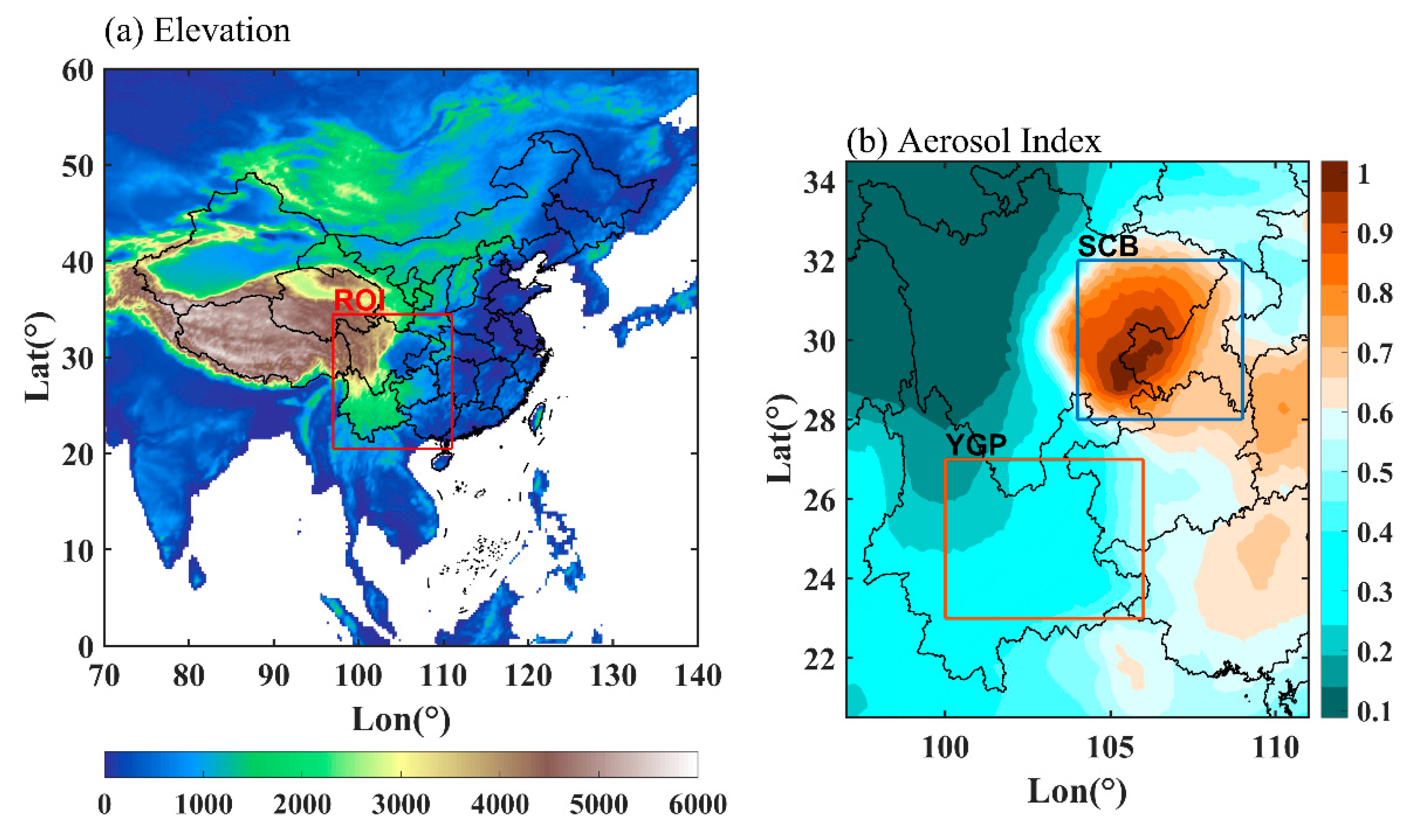

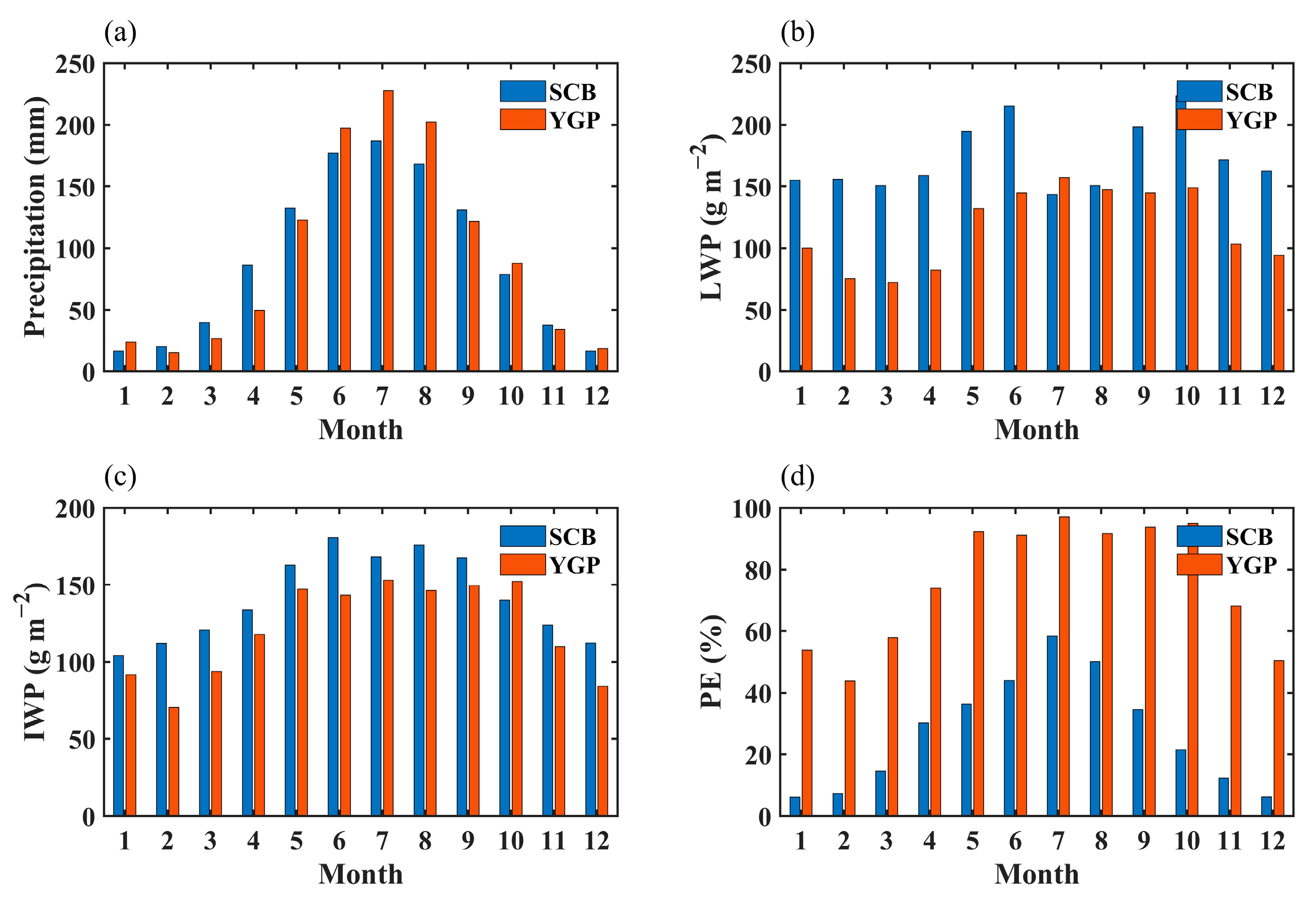
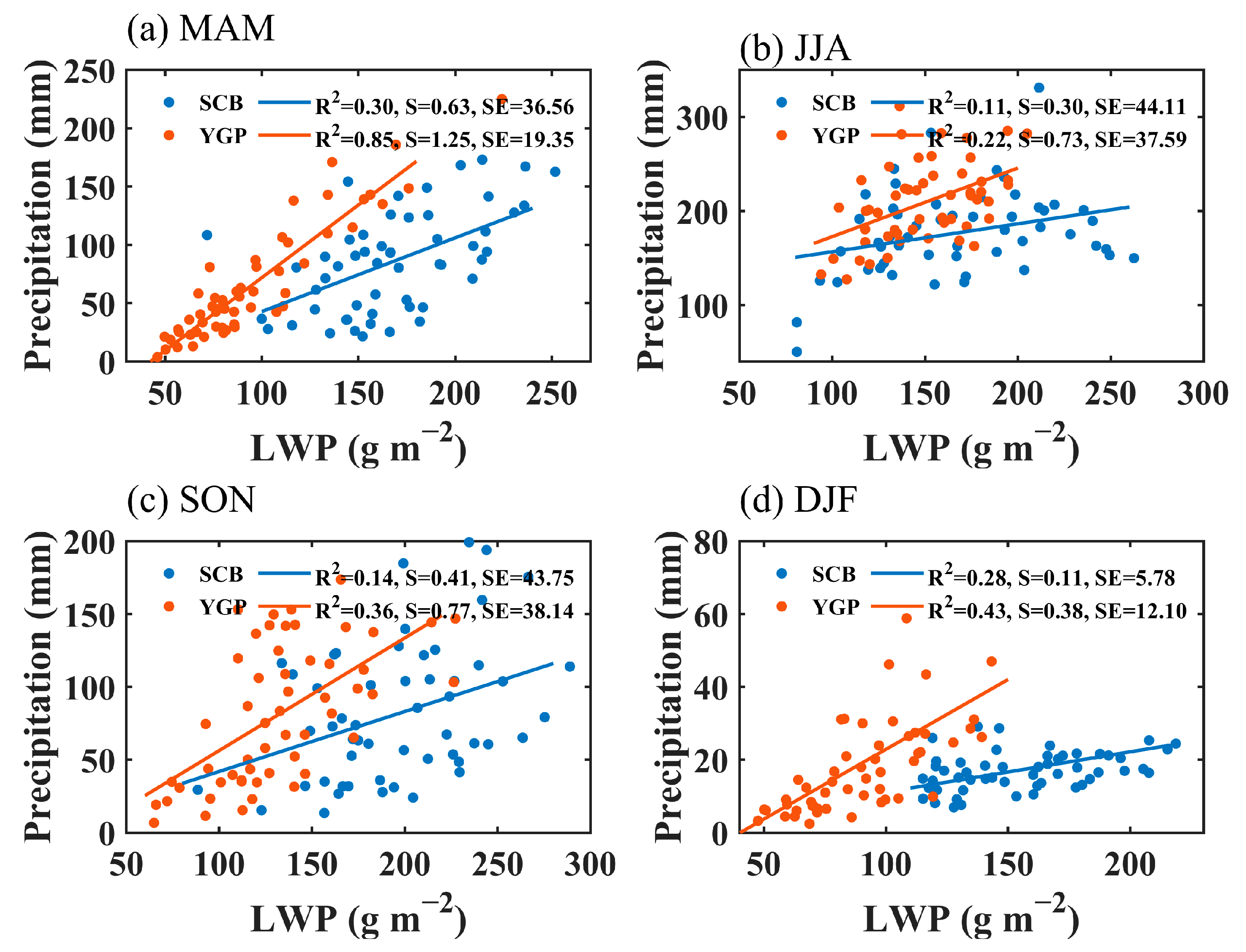
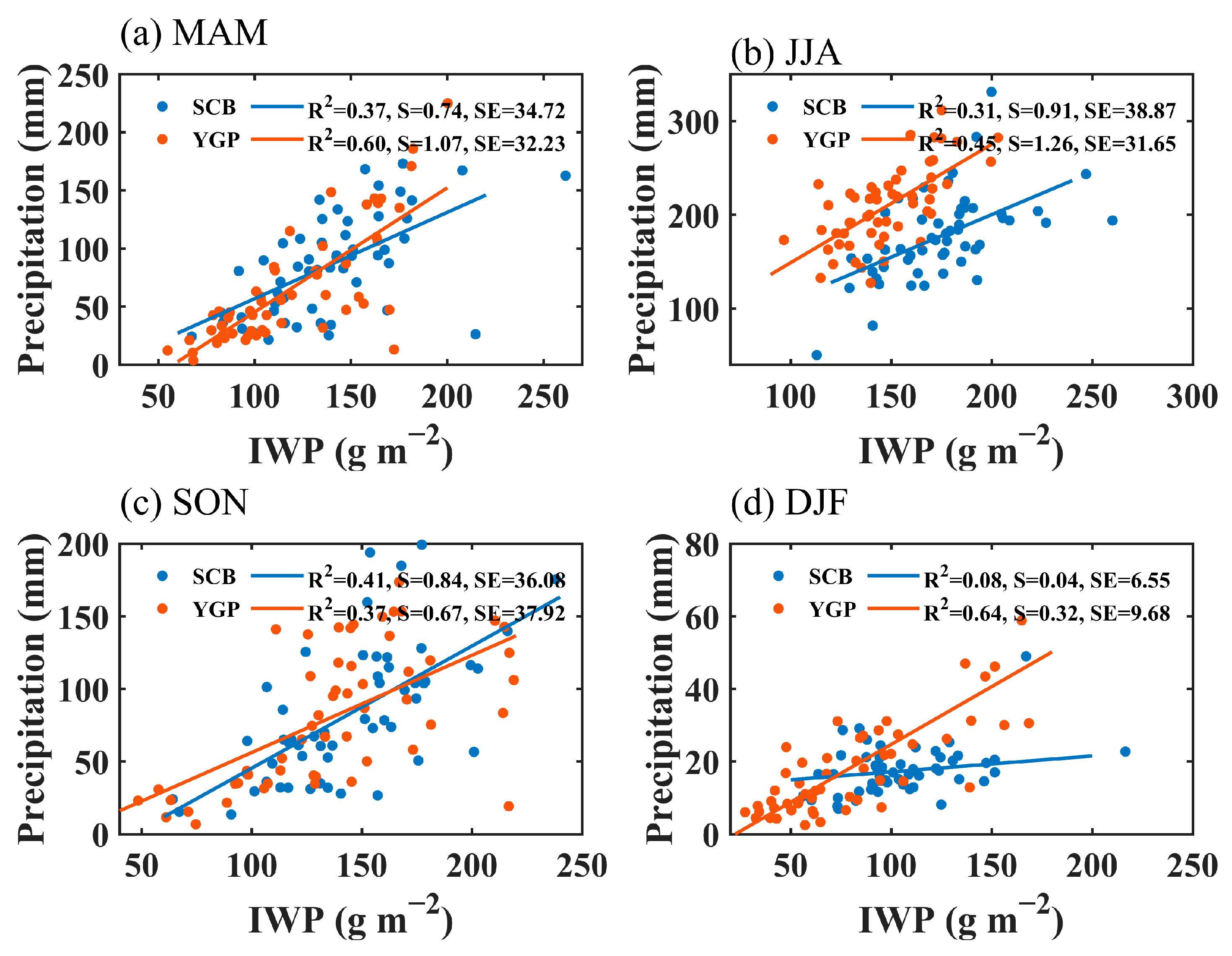


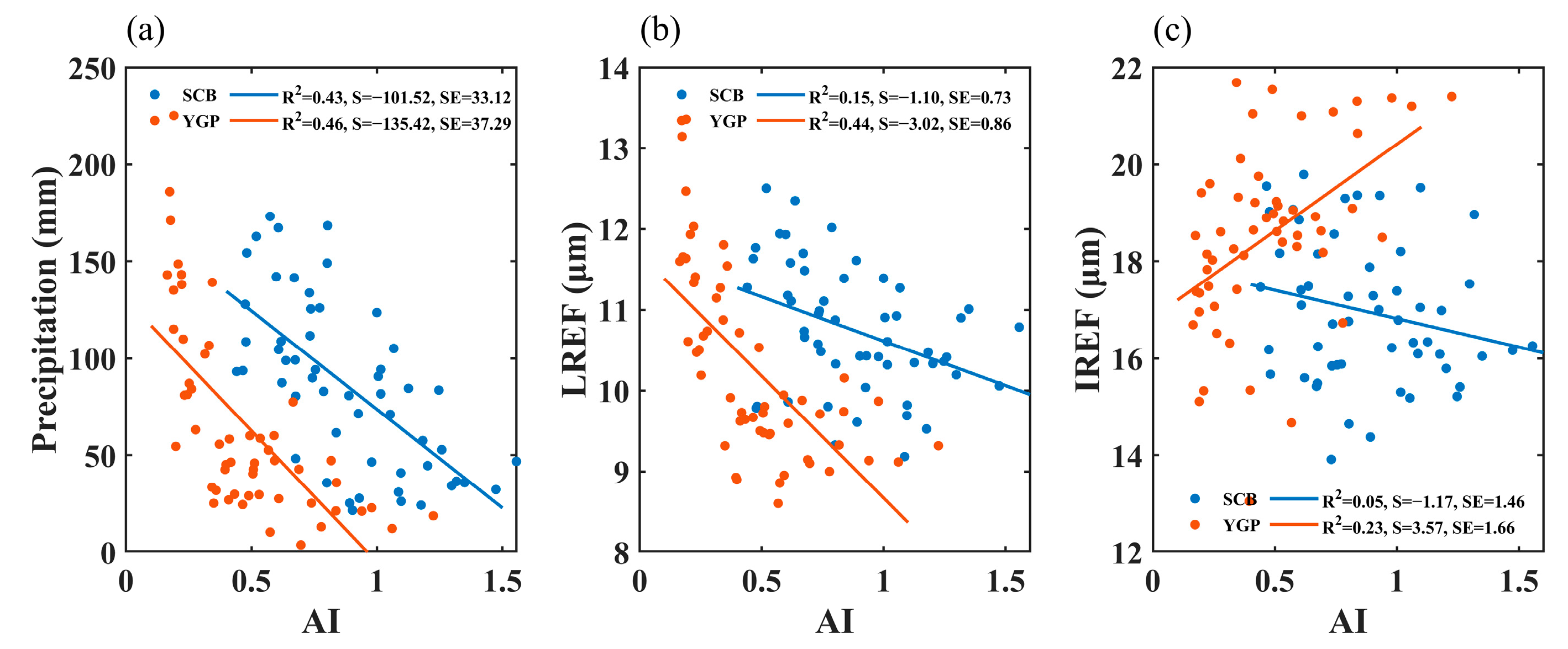
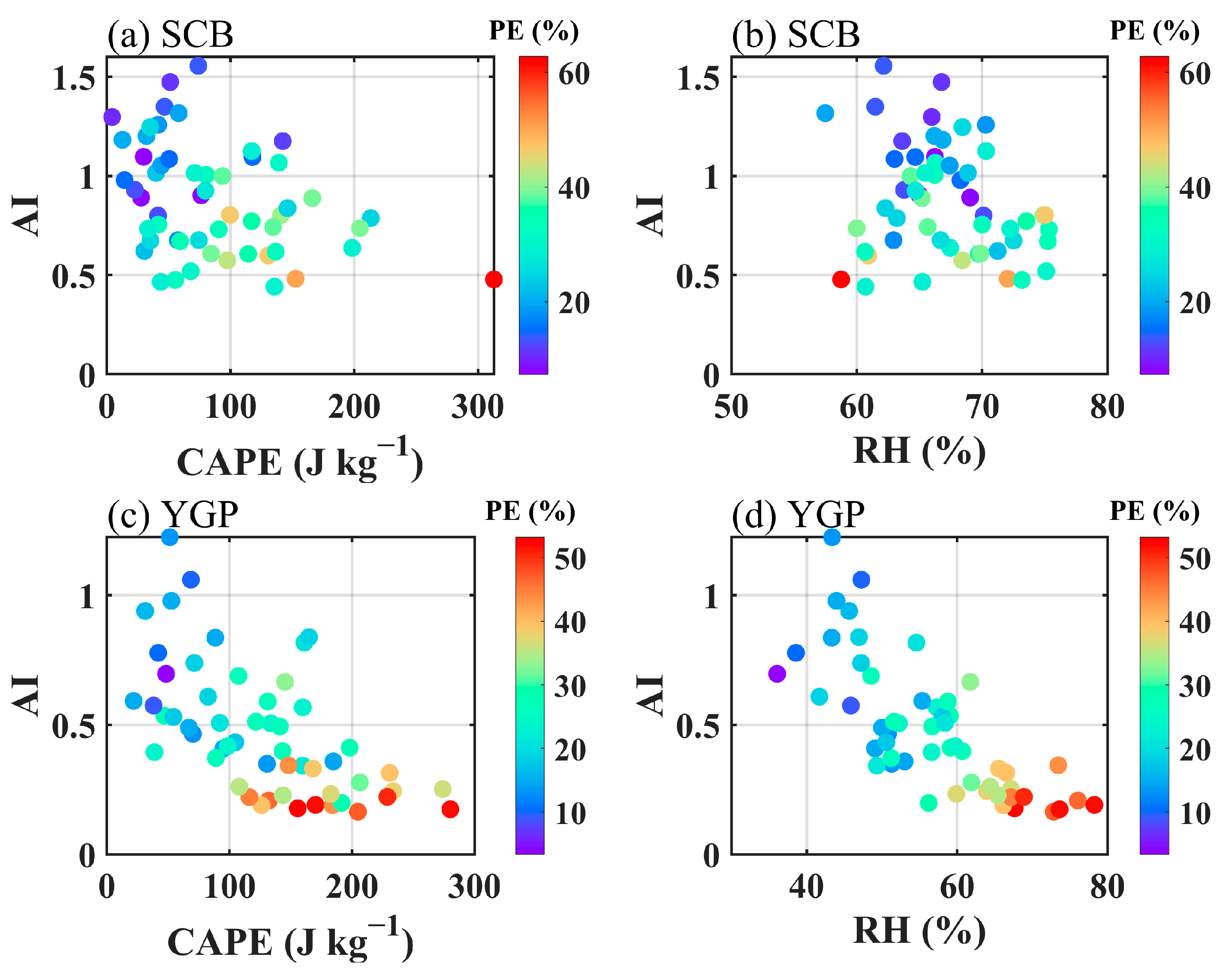
Disclaimer/Publisher’s Note: The statements, opinions and data contained in all publications are solely those of the individual author(s) and contributor(s) and not of MDPI and/or the editor(s). MDPI and/or the editor(s) disclaim responsibility for any injury to people or property resulting from any ideas, methods, instructions or products referred to in the content. |
© 2024 by the authors. Licensee MDPI, Basel, Switzerland. This article is an open access article distributed under the terms and conditions of the Creative Commons Attribution (CC BY) license (https://creativecommons.org/licenses/by/4.0/).
Share and Cite
Zhao, P.; Liu, X.; Zhao, C. Potential Modulation of Aerosol on Precipitation Efficiency in Southwest China. Remote Sens. 2024, 16, 1445. https://doi.org/10.3390/rs16081445
Zhao P, Liu X, Zhao C. Potential Modulation of Aerosol on Precipitation Efficiency in Southwest China. Remote Sensing. 2024; 16(8):1445. https://doi.org/10.3390/rs16081445
Chicago/Turabian StyleZhao, Pengguo, Xiaoran Liu, and Chuanfeng Zhao. 2024. "Potential Modulation of Aerosol on Precipitation Efficiency in Southwest China" Remote Sensing 16, no. 8: 1445. https://doi.org/10.3390/rs16081445





